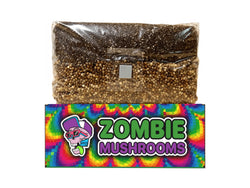⬇️ Prefer to listen instead? ⬇️
- Wood ear mushrooms do well in shade and dampness, especially on hardwoods like oak or maple.
- Science shows they can reduce swelling and protect against cell damage, which is good for health.
- Wood ear mushrooms take 8-12 months to grow big enough to pick, but once you get them started, they don't need much care.
- Lots of people around the world are growing mushrooms to sell, and wood ears are one type of edible mushroom that's in demand.
- If you're new to growing, watch out for problems like bugs getting in and the air getting too dry or too wet.
The market for edible mushrooms around the world is now worth over $42 billion Zhang et al., 2021, so it's not surprising that wood ear mushrooms are becoming more liked by cooks, foragers, and people who grow food at home. These interesting mushrooms have a unique feel, can be grown in a way that's good for the earth, and have good things in them for health and medicine. If you think growing mushrooms is cool or want to add something different to your garden that's also useful, wood ear mushrooms are a good choice, even if they can be a bit tricky.

What Are Wood Ear Mushrooms?
Wood ear mushrooms, also called Auricularia auricula-judae and similar kinds in the Auricularia group, are jelly-like mushrooms that grow in warm, damp places around the world. People in Chinese medicine and Asian cooking have valued them for a long time. They are known more for how they feel in your mouth than for their taste.
They look like ears or small jellyfish and grow on wood that's rotting, mostly on elder and maple trees. When they are fresh, they feel like jelly and are rubbery. When they dry out, they get hard and black. In cooking, people like them in dishes where texture is important, like hot and sour soups or cold spicy salads.
These mushrooms also do an important job in nature as saprobic fungi, helping to break down wood and put nutrients back into the environment.

Culinary & Nutritional Appeal of Wood Ear Mushrooms
Wood ear mushrooms don't have much taste, but they soak up flavors like a sponge. They can take on the taste of good broths, spices, and oils to become a great part of a dish. But it's mostly how they feel, not taste, that makes them special. The slight crunch and chewiness add something different to soups, stir-fries, and cold dishes.
Nutritional Profile
Wood ear mushrooms are surprisingly good for you. Here's why they are good to eat
- Low in Calories: Great if you are watching your weight.
- High in Fiber: Good for your digestion.
- Rich in Antioxidants: Help protect your cells from damage and aging.
- Blood Circulation Support: Traditional Chinese medicine says wood ears help blood flow better.
- Anti-inflammatory Benefits: A study in 2014 by Jeong et al. found that stuff taken from Auricularia auricula-judae using ethanol could really lower signs of swelling in lab tests.
- Iron and Vitamin B2 Content: Give you nutrients that help with energy.

Identifying Wood Ear Mushrooms in the Wild
Finding wood ears in the wild is pretty safe because they look different and don't have many lookalikes that are dangerous, unlike some other wild mushrooms.
Key Identification Features
| Feature | Description |
|---|---|
| Shape | Shaped like an ear, with wavy edges, like a lobe or flap |
| Size | 2–15 cm across, grow in groups |
| Texture | Like jelly when wet, rubbery and bendable |
| Color | See-through brown, from light brown to almost black |
| Underside | Smooth or with tiny hairs |
| Location | On dead hardwood trees, mostly elder |
| Spore Print | White |
When wood ears dry out while still on the wood, they get brittle and dark, looking like bits of thin plastic. After it rains, they get wet again and puff up, becoming easy to spot.

Foraging Tips and Lookalike Precautions
Picking wood ear mushrooms can be fun, good for nature, and taste better than what you buy in stores—if you know what to look for!
Best Foraging Conditions
- Season: Spring and fall, but they might show up all year in wet places like.
- Weather: After it has rained for a few days.
- Location: Rotten logs or branches on the ground in the woods, mostly where deciduous trees grow.
Foraging Do’s and Don’ts
Do
- Choose ones that are thick and wet.
- Cut them with a clean knife so you don't hurt mushrooms that are still growing.
Don't
- Mistake them for Witch’s Butter (Phaeotremella foliacea), a jelly-like mushroom that you can eat but it feels different and can grow on pine trees. It's clearer and doesn't bounce back like a real wood ear.
- Pick them from dirty places—parks in cities or roadsides might have logs that are not clean.
Foraging helps you understand nature better and get a tasty treat at certain times of the year. Always pick in a way that keeps nature healthy by only taking some of what you find.

Are Wood Ear Mushrooms Hard to Grow?
Growing wood ears is kind of in the middle when it comes to how hard it is to grow mushrooms. They are a bit harder than oyster mushrooms, but much easier than morels or truffles.
What Makes Them Challenging?
- Humidity Requirements: The air must be damp all the time, over 85% to get them to grow fruit.
- Long Incubation: It can take 8–12 months for them to grow big enough to pick when growing outside.
- Airflow Needs: They need dampness, but air that doesn't move can cause mold.
- Substrate Preferences: They like fresh hardwood—if you use the wrong stuff, you won't get much.
Why They’re Still Beginner-Friendly
Once you get the growing area right, wood ears are not too fussy. Many growers say they get good harvests on both logs and bags of sterilized sawdust, even if they don't do much while they are growing.

How to Grow Wood Ear Mushrooms on Logs
If you want a way to grow wood ear mushrooms that lasts and is good for the environment, growing them on hardwood logs is a great idea. It's like how they grow in nature, and you can get mushrooms for years with little work.
Outdoor Cultivation Guide
| Step | Details | Pro Tip |
|---|---|---|
| Select Logs | Use hardwood that was just cut, like oak, maple, or elder, 4-6 inches across | Cut them when trees are not growing much—late winter to early spring |
| Clean Logs | Wash off dirt but don't use soap or chemicals | Keep the bark on |
| Soaking Logs | Put logs underwater for 24–48 hours to get them wet inside | Use rain or well water—don't use tap water with chlorine |
| Inoculation | Drill holes about 6 inches apart and put in plug, sawdust, or grain spawn | Do this in spring or early fall to get the best results |
| Seal with Wax | Use beeswax or cheese wax to help keep water in and keep bad things out | Cover all the spots where you put in spawn well |
| Log Placement | Stack logs in shady, damp places standing up or in a stack | Keep logs damp but not too wet |
You might see the first mushrooms in 8–12 months, and then get more harvests for up to 5 years, depending on how good the logs are and how healthy the mushroom root system is.

Indoor and Alternative Methods for Growing Wood Ear Mushrooms
If you want to grow them inside or just a little bit, growing in bags or containers is best.
Supplies You’ll Need
- Sterile Substrate: Straw that has been pasteurized, sawdust, or hardwood pellets that have extra nutrients.
- Plastic Grow Bags or Buckets: With tiny filters that let air in and out.
- High Humidity Chamber / Tent: A plastic tent or a machine that makes air damp automatically.
- Wood Ear Mushroom Spawn: You can buy this online or from mushroom farms.
Growth Environment
| Variable | Ideal Range |
|---|---|
| Temperature | 60–70°F (15–20°C) |
| Humidity | 85–95% RH |
| Light | Natural light but not direct sun |
| Airflow | Air that is clean and moves gently |
Grow kits from places like Zombie Mushrooms can make it easier for beginners. They sell bags or substrates that already have mushroom spawn in them, which means less chance of getting bad stuff growing and less work for you.

Troubleshooting Common Cultivation Issues
It's normal to have problems when growing mushrooms. Here's how to fix them fast
| Problem | Cause | Fix |
|---|---|---|
| No Fruiting | Too dry or too dark | Spray water every day and let in some light but not direct sun |
| Thin/Dried Mushrooms | Not enough water or too much air moving | Make the air more damp, make air move less around the growing stuff |
| Mold Contamination | Not enough air moving or tools not cleaned well | Clean everything you use; let more air move around |
| Bugs or Pests | Growing outside, not clean enough | Use covers with small holes and don't leave sugary stuff around |
| Spotty Mycelium Spread | Bad growing stuff or weak spawn | Use good spawn and fresh hardwood growing stuff |

Harvesting and Preserving Your Crop
Harvesting Guidelines
- Appearance: Pick them when they look full, bend easily, and are wet.
- Cutting Method: Use a clean knife; don’t pull or rip them off.
- Repeat Flushes: Wood ears grown on logs might grow mushrooms many times in a season.
Storage Tips
| Method | Details | Shelf Life |
|---|---|---|
| Refrigeration | Put fresh mushrooms in paper bags—never plastic | 5–7 days in the fridge's crisper |
| Drying | Use a food dryer at 110°F or dry them in the sun until they feel like leather | Many months if kept in a cool place |
Wood ears that have been dried and then soaked in water again will still feel the same. Put them in water for 15–30 minutes and they will go back to how they were, ready to cook.

Cooking Ideas and Recipes
Wood ear mushrooms can be used in many ways in cooking. They don't have a strong taste, so they are good in both Asian and mixed-style dishes.
Flavor Pairing Ideas
| Culinary Base | Complements |
|---|---|
| Broths | Miso, soy, ginger |
| Proteins | Tofu, chicken, tempeh |
| Vegetables | Bok choy, bell peppers, carrots |
| Sauces | Sesame oil, hoisin, black bean sauce |
Top Recipe Ideas
Wood Ear & Cucumber Salad
Soak dried wood ears in water until soft, then mix with cucumber cut into thin strips, rice vinegar, sesame oil, soy sauce, and crushed garlic. Serve cold with chili flakes if you like it spicy.
Spicy Stir-Fry with Tofu
Quickly fry sliced wood ears with tofu cubes, sliced ginger, garlic, and scallions in chili oil. Add a little Shaoxing wine at the end.
Medicinal Broth Soup
Cook wood ears gently with goji berries, jujube fruits, ginseng slices, and a little miso paste for a soup that's good for you.
Final Verdict: Are Wood Ear Mushrooms Worth Growing?
Yes, definitely. Wood ear mushrooms are more than just a fun texture in food—they are good for your health, not expensive to grow, and a cool way to get closer to nature, whether you grow them in the woods, a greenhouse, or on your balcony in the city.
If you put in a bit of work and pay attention to the growing conditions, these interesting mushrooms will give you harvests for more than one season and make cooking fun. If you are a beginner who wants to try something other than the usual vegetables from the store, or someone who knows a bit about mushrooms and wants a new challenge, wood ear mushrooms are really worth trying.
Start small, try different things, and enjoy the chewy mushrooms you get.




